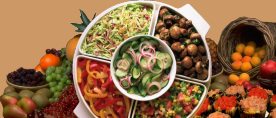Salads' Simple Secrets
A World in a Word
The word "salad" probably triggers thoughts of lettuce first for most people, right next to the adjective "boring."
But I'll let you in on one of salad's simple secrets: Salad is one of the most versatile dishes you can make. The possible combinations of ingredients are so numerous that you could serve two or three salads at one meal and not repeat a major ingredient! (Try it!)
With dozens of vegetables, dozens of fruits, many kinds of nuts, beans, grains, cheese, and even meats to choose from, the options are limited only by your imagination and what's available. Add the range of choices in dressings and seasonings and you can see that there's a whole world of flavor combinations waiting to be explored.
And with the vitamins and minerals of organic foods, unprocessed oils, and quality vinegar or lemon juice, salads pack a major nutritional punch.
What Is a Salad, Anyway?
To my mind, the main feature of a salad is its being served cold. It doesn't have to be raw; it doesn't have to be dressed; but it should be cold. It should also have things that need to be chewed (otherwise it's soup). That's about it.
So if you've been stuck in the lettuce and tomato rut (with maybe the occasional cucumber thrown in), consider the wide range of foods that can pull you out called "salad."
I mean, think about some of the more unusual salads you may have heard of or tried: Waldorf Salad (apples and raisins), chef's salad (cold cuts added), potato salad (not a leaf of lettuce in sight!), Mexican salad (corn and peppers), gazpacho (tomato-based chopped salad), spinach salad (with bacon and walnuts), and more...some yet to be named or even invented!
Where Salads Reign
What if instead of the standard meat-potato-vegetable dinner, you served a meal with a small portion of cooked food and two or three cold salads? Revolutionary, I know. Maybe even un-American. But one of the things that makes the Standard American Diet so S.A.D. is its reliance on cooked (and even overcooked) foods.
Our national standards require many more servings of vegetables than most of us get. The first step to eating more vegetables and fruits may be to stop thinking "cooked" and start thinking "salads." Raw vegetables are good on so many levels, not the least of which is: It's hard to get fat on vegetables...but it's easy to get healthier!
So get out those recipe cards and shopping lists and make "salad" one of your favorite meal-lplanning concepts. Salad's simple secrets will reward your body well.

